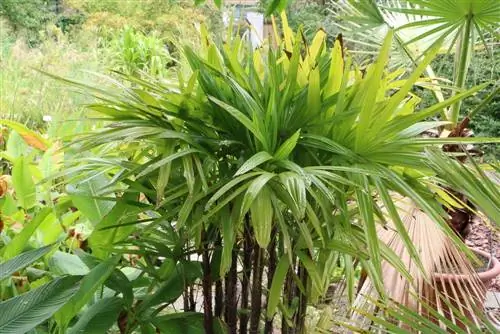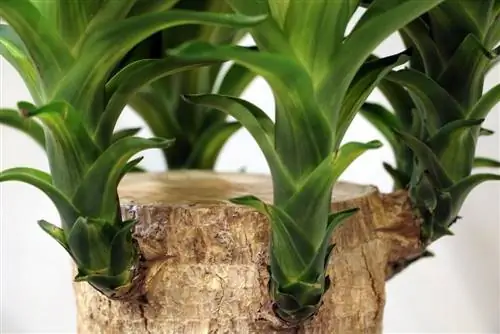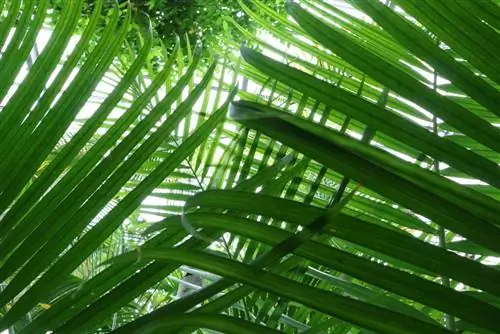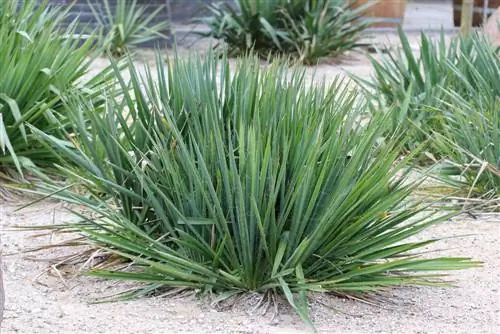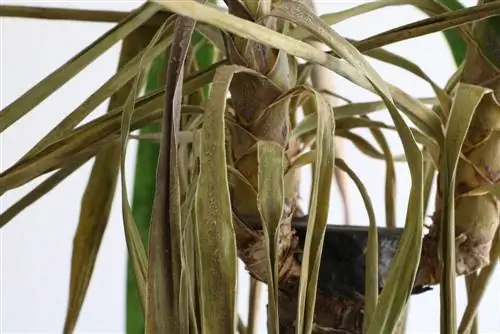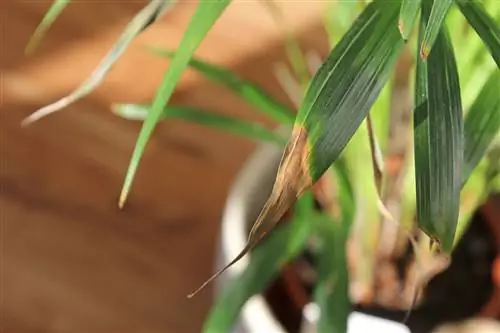- Author admin [email protected].
- Public 2023-12-17 03:39.
- Last modified 2025-01-24 12:45.
The genus of stick palms (Rhapis), which comes from China and Japan, includes 9 known species. The undemanding, evergreen and exotic-looking stick palm (also Chinese stick palm, lady palm, umbrella palm) forms tube-like stems in the upper part of its reticulated leaf sheaths, from which the name stick palm is derived. The stems growing from the fiber-covered wooden trunks, which are approximately 3 cm thick, produce the green leaves divided into fan rays. Even in a pot size of 30 cm, the palm tree reaches a height of around 1 meter. The lower dried leaves of the palm can be separated.
Substrate & Soil
The palm tree thrives particularly well on a well-drained and slightly pH-acid substrate. The plant substrate made from a compost-based mixture has proven particularly effective. To do this, the potting soil is mixed with sharp sand, gravel and lava granules or expanded clay.
Fertilize
You can fertilize during the main growing season from spring to late summer with a commercially available palm fertilizer. A liquid fertilizer is added to the irrigation water every 14 days; alternatively, a long-term fertilizer (granules) can also be used.
Cutting
A cut is not necessary.
Propagate
The shoots separated from the mother plant in spring are placed in a substrate mixture of two parts compost soil and one part sharp sand. The substrate is moistened well and the pot is covered with a transparent film to create a climate that promotes growth. The cut ventilation holes prevent mold from forming on the substrate. After four to six weeks in sunlight, the offshoot begins to sprout - the film can be removed and the plant can be watered normally. However, fertilization is only carried out as soon as the cuttings are planted in a normal pot.
Offshoots that are cut off directly at the base of the mother plant usually already have roots so that they can be potted directly into normal potting soil. The flower palm can also be grown from seeds.
Wintering
Although the palm tree can tolerate temperatures as low as 6 °C in the short term, the Rhapis Excelsa should be accustomed to a protected location as early as September. If the lighting conditions are right, it can easily overwinter in the house or garage. In winter it should be given 3 to 4 hours of sunlight every day if possible. The temperature during the rest period is ideally 10 to 12 °C. If the palm tree overwinters in a heated room, special attention is required because the soil should be neither too moist nor too dry during the low-light season that begins the rest period. Fertilization is not carried out during the rest period, even if the winter is warm. During the low-light period, the plant does not develop any new runners and uses the existing strength to slightly grow its roots.
Location
The stick palm actually lives in the forest, well protected under the leaves and fronds of larger plants. The palm tree feels really comfortable in a semi-shady place (at least 700 lux). The Rhapis excelsa can also tolerate a little direct sun in the morning and afternoon. If there is too much sun, the leaves turn yellow.
Tip:
If the palm tree is outdoors, the blazing midday sun should be avoided.
Temperature
Normal room temperatures (15 to 20 °C) ensure balanced growth of the palm tree, although this slows down as temperatures fall. If the temperature falls below approx. 8 °C, the Rhapis excelsa takes a break.
Tip:
The cutting palm is also suitable for the pot and can withstand even short periods of frost.
Repotting
In its homeland, the stick palm reaches a height of up to 5 meters and its underground rhizomes form several trunks. If the pot becomes too narrow, it can be repotted immediately after the rest period in winter. If the woody trunks crowd the edge of the pot or the roots are already pushing out of the top of the pot, a slightly larger plant pot should be chosen. However, because the palm tree grows very slowly, it can spend many years in the same pot. Spring is also ideal for renewing the substrate - as long as the pot size is maintained. As with many other types of palm trees, the palm tree prefers a rather deep pot in order to be able to develop its long rhizomes. The palm tree also absorbs most of its nutrients through its roots, with the deep-growing roots also giving it a secure footing. The deeper and wider the pot, the more difficult it is to water the plant evenly.
Pouring
The floral palm must not dry out and it needs well-moisturized soil for balanced growth. Care errors are noticeable in brown or yellow leaves. As soon as the top layer of the substrate has dried slightly, the palm tree is watered. The soil is well moistened. Although the flower palm is less sensitive than other plants, waterlogging should be avoided and no “foot of water” remains in either the pot or the saucer. In winter the Rhapis excelsa takes a break and is only watered moderately as soon as the substrate has dried well.
Diseases and pests
Pests can also attack the robust palm tree if it is not cared for correctly or in a location where it is not located. Scale insects, spider mites or mealybugs usually initially hide at the base of the fronds. Special plant protection products provide relief. In principle, pests can also be collected by hand. However, rinsing is not necessarily recommended, as the pests are usually distributed on the plant and in the soil.
Yellow leaves are often the result of a substrate that is too wet. Brown leaf tips form when the humidity is too low. If the brown tips are cut back, a little of the wilted leaf should remain to prevent the wound from wilting further. If the plant has been overwatered or overfertilized and is already showing signs of damage, the substrate can be replaced; this can also be useful during the winter period. If possible, unfertilized potting soil is used to give the palm tree a break.
Irrigation
- Increasing the humidity is good for the palm tree, but is not absolutely necessary for it to thrive.
- As with watering, water that is as low in lime as possible should be used to avoid unsightly limescale stains on the leaves.
- The watering is done with tap water at room temperature, but it should not be too calcareous.
What you should know about the stick palm in brief
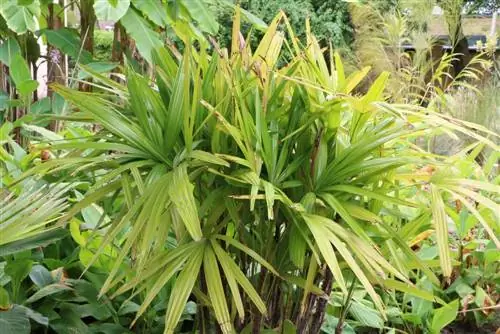
The stick palm is one of the umbrella palms. It originally comes from Southeast Asia and grows very slowly. It has underground rhizomes through which several trunks form, giving the impression of a small group of palm trees. The palm tree is usually cultivated as a houseplant, but can also be used as a container plant. In home culture, the palm tree grows to a height of about 1.5 meters. Rhapsis excelsa is an excellent air freshener in the sense of breaking down pollutants and evaporation. This palm grows very well in hydroponics.
Location
- The stick palm is a forest dweller. There she is protected from the sun. In our case, the plant also prefers a partially shaded location.
- The palm tree tolerates morning and evening sun well. It can also stand in the shade, but then it hardly grows.
- Prolonged exposure to sunlight may cause the leaves to turn yellow.
- The Rhapis excelsa does well in rooms with slightly less light. But it should be at least 700 lux.
- In winter, the palm tree must receive at least 3 to 4 hours of sunlight per day, if possible.
Planting substrate
- The planting substrate should be very permeable and slightly acidic.
- A compost-based mixture to which you add some sharp sand, gravel, expanded clay or lava granules is ideal.
- Repotting takes place in spring. But this is only necessary when the roots push out of the top of the pot.
- It often takes many years for this to happen. You only use a slightly larger plant pot.
- A slightly taller planter is well suited. Palm trees form taproots and they require downward space.
Care
- Rhapis excelsa likes high humidity. If you spray her with water every now and then, she feels very comfortable.
- Just like for watering, you shouldn't use hard water, palm trees don't like that.
- The water requirement of the flower palm is moderate. During the main growing season, water the plant abundantly.
- The plant ball should be well moistened after watering. Rhapis excelsa doesn't like standing water.
- After watering, wait a few minutes and then pour out the saucer or planter and remove any excess water.
- Before the next watering, let the top layer of the plant substrate dry thoroughly.
Fertilize
- You fertilize either with a commercially available liquid fertilizer, then every 14 days in the growth phase from spring.
- Or you can use a long-term fertilizer that you work into the top layer of substrate.
Wintering
The stick palm has to be discontinued in mid-September. Overwintering can take place in the living room. If there is no space there, another room will do. It requires temperatures between 5 and 10 ºC. During winter rest, you only water enough to ensure that the plant ball does not dry out. When the air is dry, floral palms, just like other palm trees, are often attacked by spider mites. Regular spraying or showering prevents this. The colder the palm overwinters, the less water it needs.
Buy
A Rhapsis excelsa, 40 to 50 cm high, costs around 10 euros. Since the palm tree grows slowly, larger specimens are significantly more expensive. With a size of 120 cm it costs around 70 euros.

